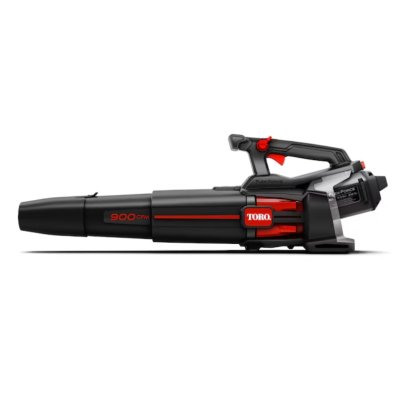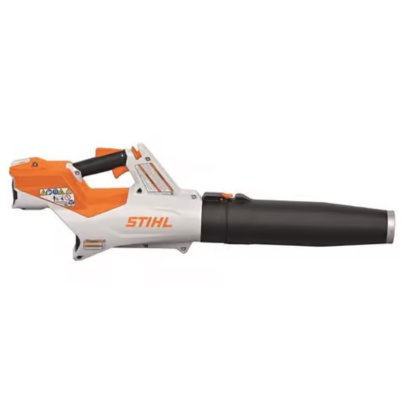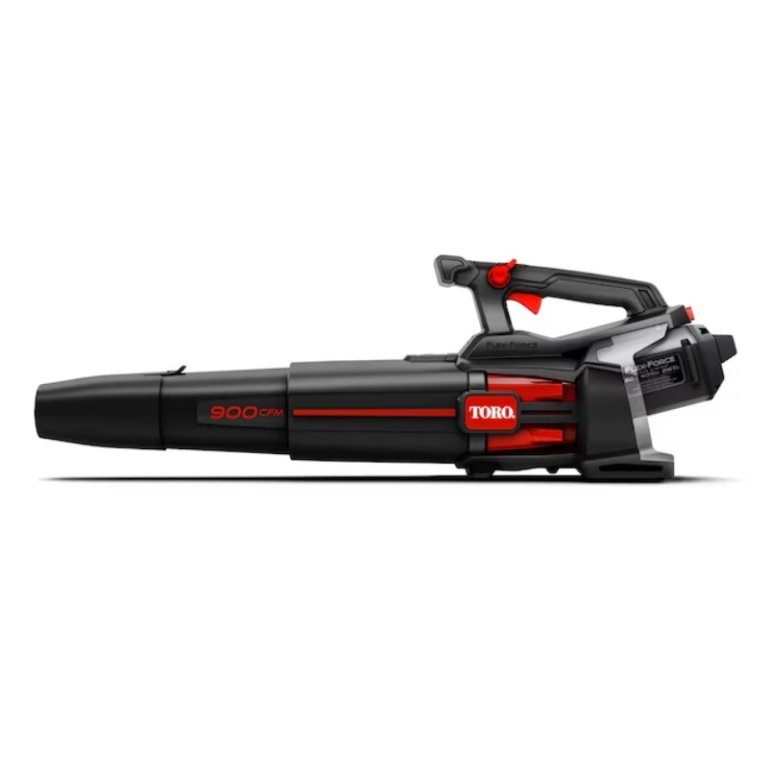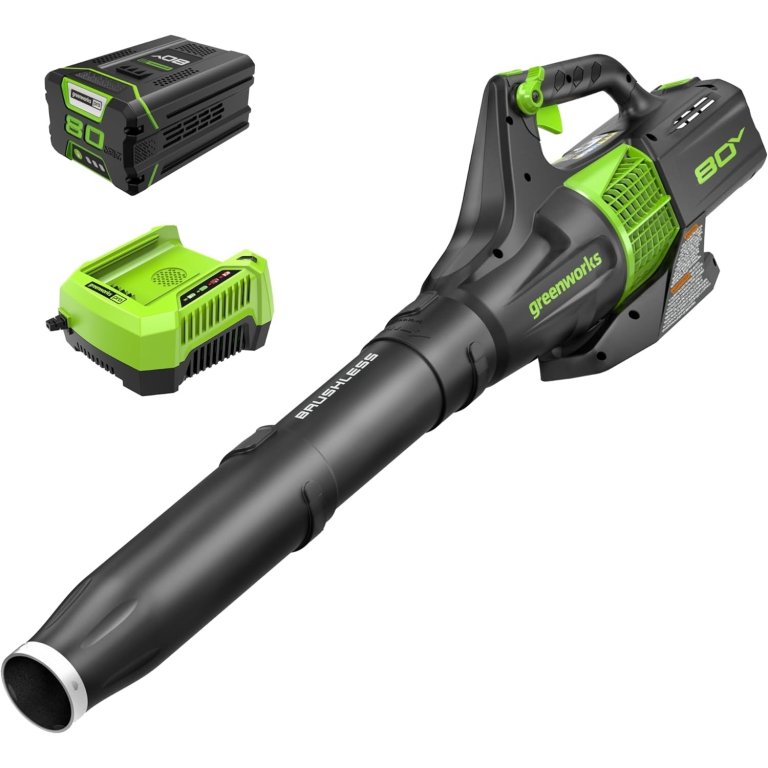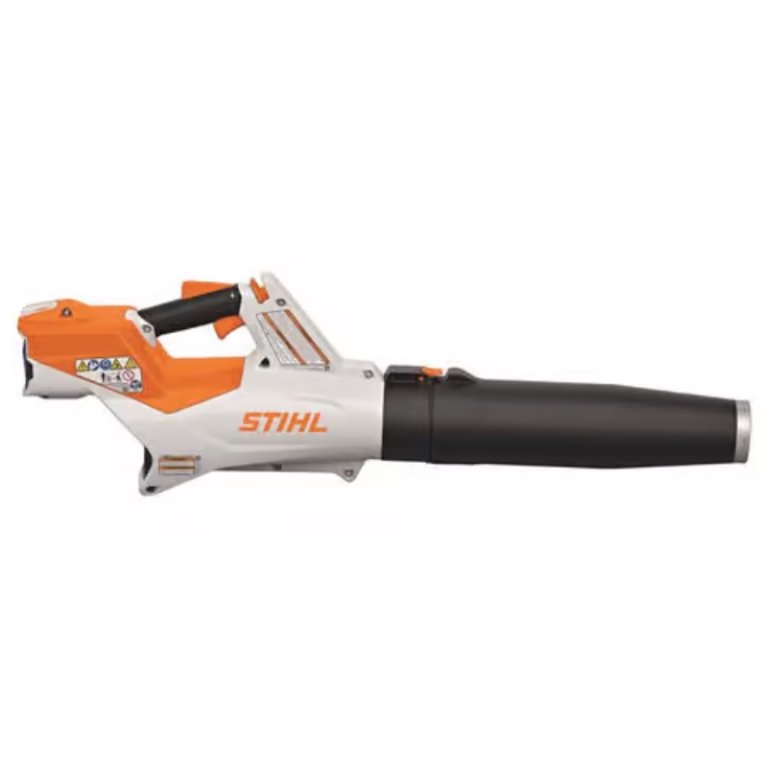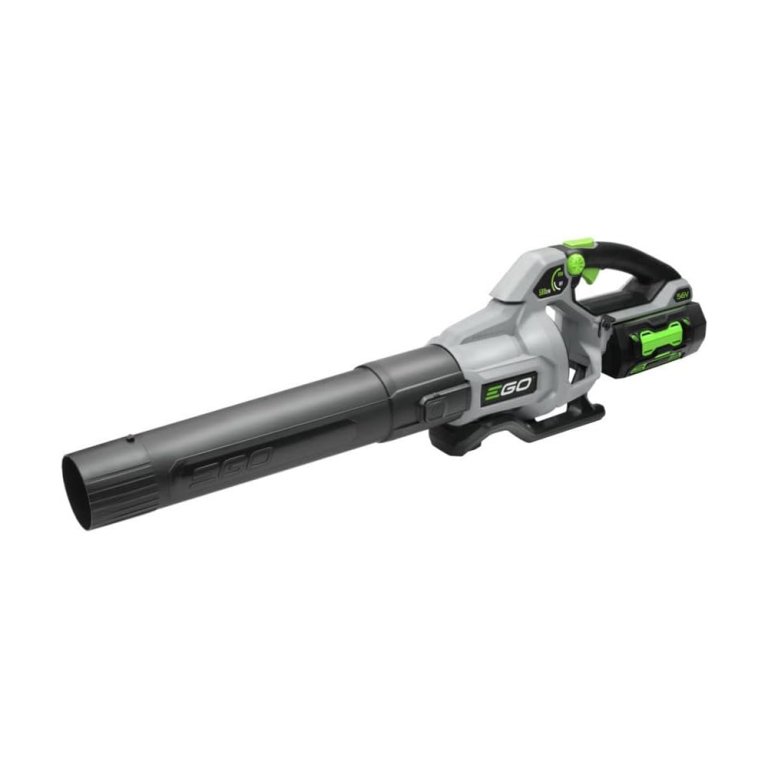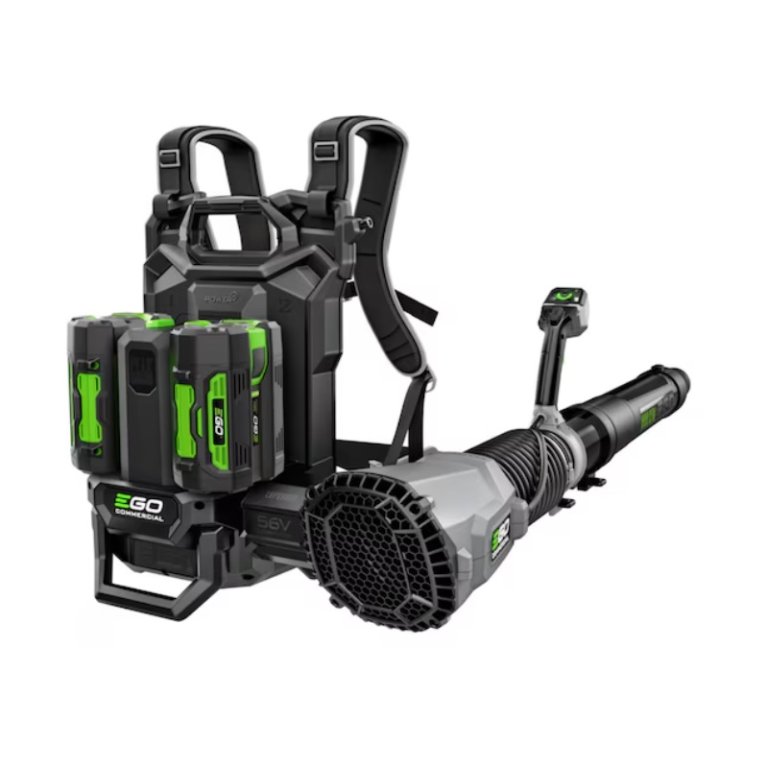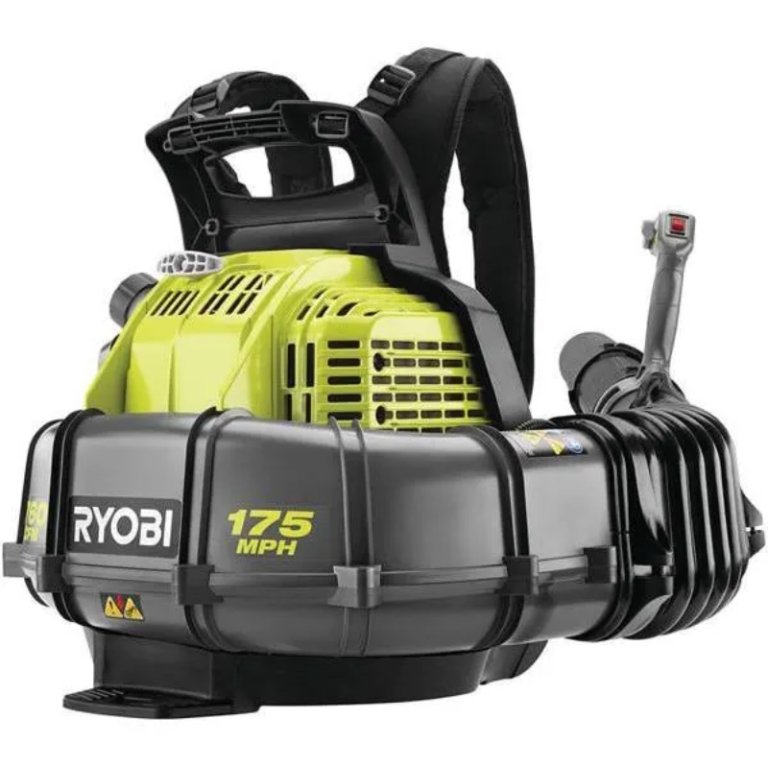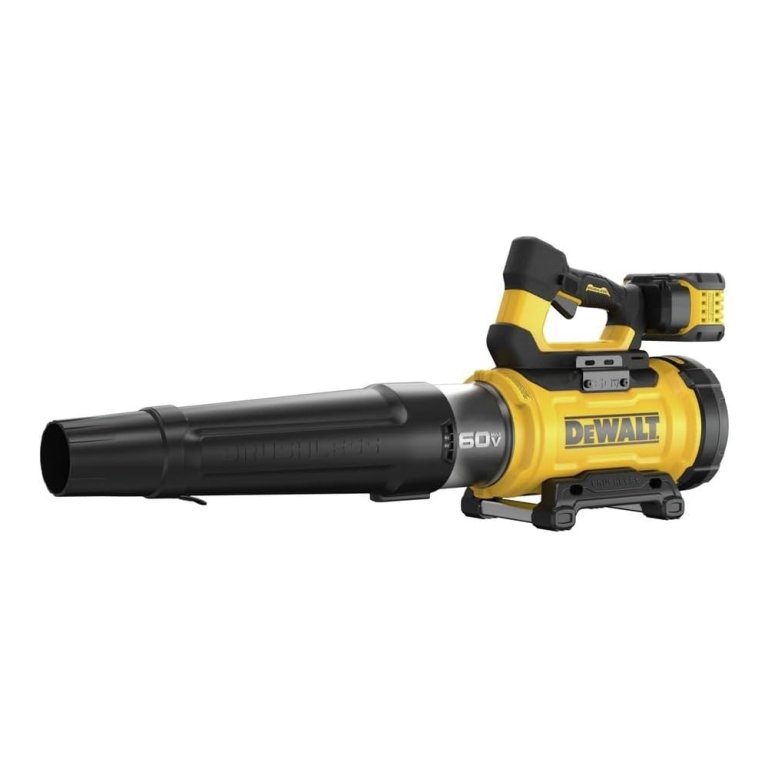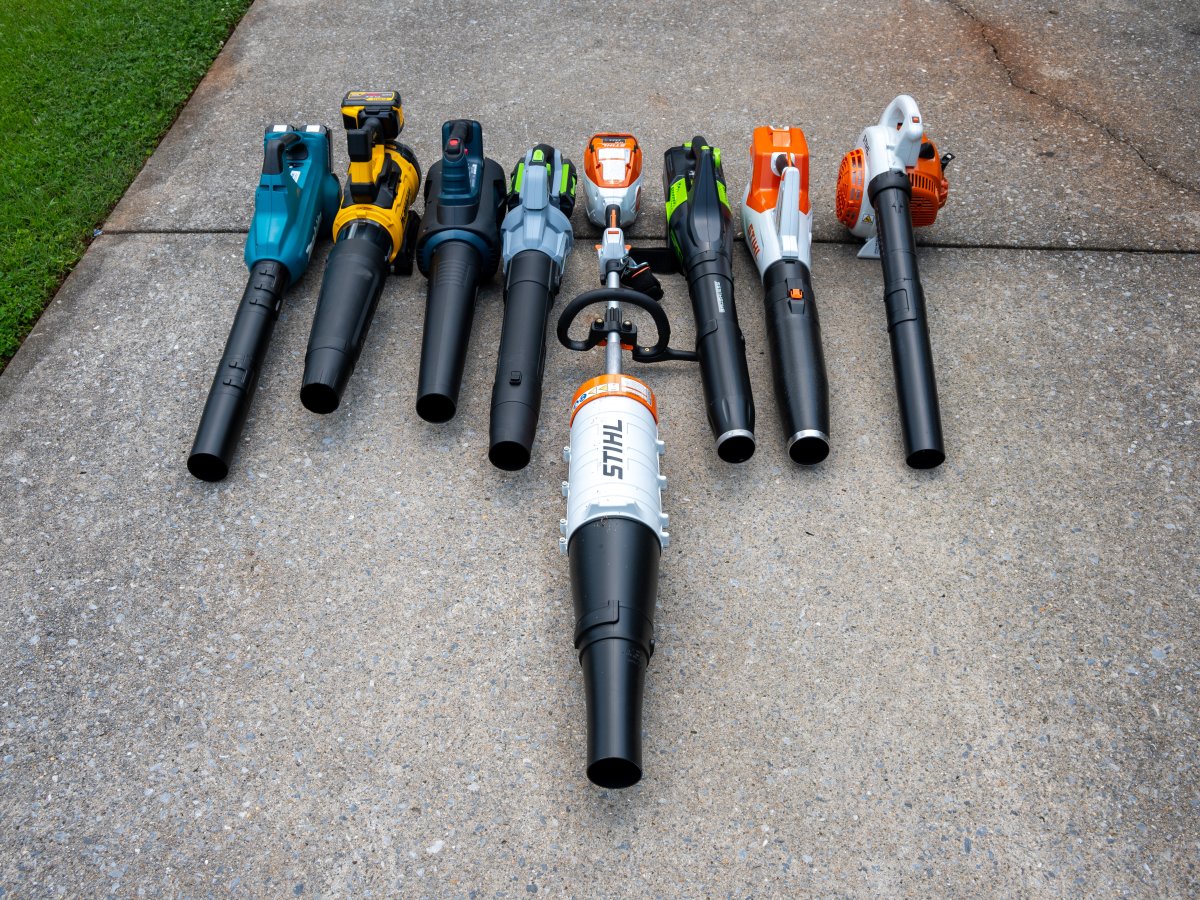
We may earn revenue from the products available on this page and participate in affiliate programs. Learn More ›
Raking leaves, shoveling snow, clearing storm debris, sweeping grass clippings—every season comes with a different kind of mess. For many of these tasks, cordless leaf blowers are the tools of choice for cleanup. Regardless of yard size, if you live in a house you probably have (or need) a cordless blower. But buying one can be a bit challenging. The recent uptick in battery-powered options and relative decline in popularity of gas leaf blowers has created some confusion within this cordless tool category. That’s why we’ve spent the past couple of years testing dozens of them, cleaning our own backyards, walkways, and lawns as we search out the top performers.
Our current favorite is the Toro 60V Max 900 CFM cordless leaf blower. It produces an incredible amount of blowing force and has plenty of battery life to tidy up large yards. It is well balanced, with a comfortable handle and intuitive controls that make yard work easier. But it’s not the cheapest or lightest option, and might even be too powerful for smaller yards. That’s why we’ve included a range of great options, including gas- and battery-powered models with different capabilities and features. Check out our reviews of the best cordless leaf blowers to find out more and see how each one performed in testing.
- BEST OVERALL: Toro 60V MAX 900 CFM Cordless Leaf Blower
↓ Jump to Review - BEST BANG FOR THE BUCK: Greenworks 80V 580 CFM Cordless Leaf Blower
↓ Jump to Review - BEST LIGHTWEIGHT: Stihl BGA 60 Cordless Leaf Blower
↓ Jump to Review - BEST BATTERY HANDHELD: Ego Power+ LB5804 580 CFM Cordless Leaf Blower
↓ Jump to Review - BEST GAS HANDHELD: Stihl BG 56 C-E Leaf Blower
↓ Jump to Review - BEST BATTERY BACKPACK: Ego Power+ Commercial 800 CFM Backpack Blower
↓ Jump to Review - BEST GAS BACKPACK: Ryobi 760 CFM Gas Backpack Leaf Blower
↓ Jump to Review - BEST RUNTIME: DeWalt 60V MAX High Power Brushless Blower
↓ Jump to Review

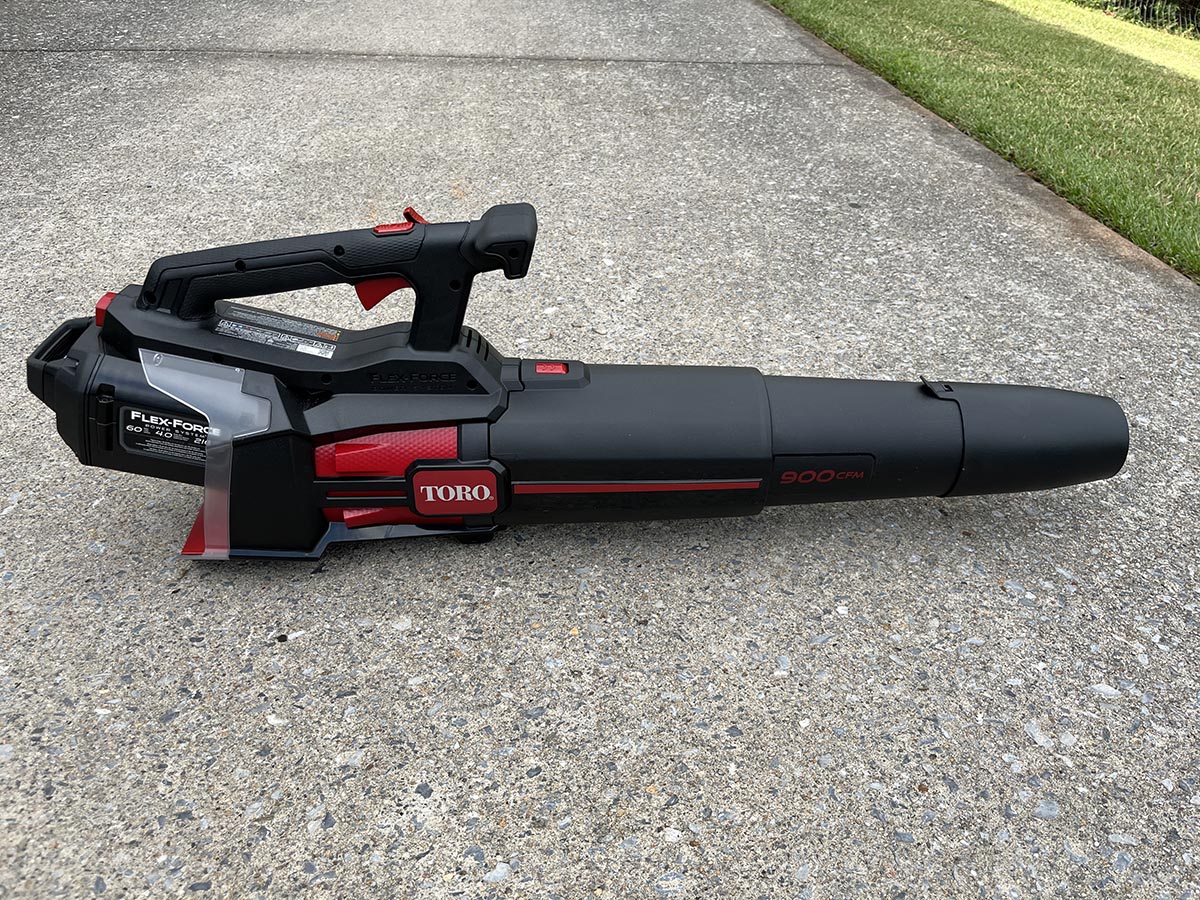
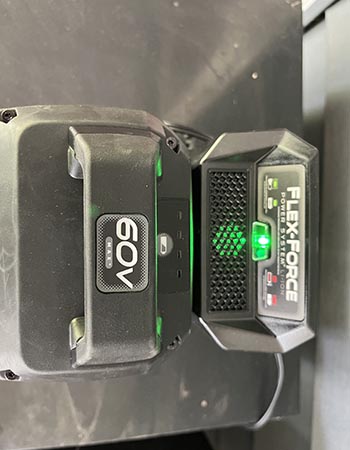

Our Top Picks
Cordless leaf blowers come in many shapes and sizes. Whether you need a compact handheld blower or a heavy-duty backpack model, the lineup ahead has you covered. Check out these reviews to find out more about each model and why we recommend it.
Best Overall
Toro 60V MAX 900 CFM Cordless Leaf Blower
What We Like
- Impressive blowing force
- Plenty of running time per charge
- Variable-speed trigger with turbo mode and cruise control
- Well balanced and easy to maneuver
- Competitive price point
What We Don’t Like
- Heavier than other cordless leaf blowers
- Slight delay after triggering
Product Specs
- Power source: 60-volt 4-amp-hour battery
- Maximum airflow: 900 cubic feet per minute (CFM)/165 miles per hour (mph)
- Weight: 12 pounds
Our Ratings: Ease of Use 5/5; Ergonomics 4/5; Performance 5/5; Noise 5/5; Value 4.7/5
Not everyone needs top-end blowing force from a handheld leaf blower, but it’s nice to have a little extra power at your disposal when you need it. The Toro 60-volt MAX 900 CFM cordless leaf blower is designed with massive air-moving ability to maintain landscapes up to 1 acre or larger. It’s also built to take on heavy-duty cleanup projects. It comes with a charger and 4-amp-hour battery that delivers up to 120 minutes of runtime and recharges in 120 minutes.
In addition to air movement that rivals some of the best gas-powered leaf blowers, we really like the design of this model. Although the Toro 900 CFM battery leaf blower was the heaviest handheld we tested, it was perfectly balanced so that the blow tube naturally rested at the correct working angle with zero effort. The handle was comfortably shaped, with a secondary forward handle for two-handed operation, and covered with a slip-resistant overmold that provided a little bit of cushion.
To us, the benefit of a comfortable, balanced design outweighed the slightly heavier weight. Since this blower shares a battery platform with the Toro TimeCutter electric zero-turn mower and the 60V MAX Recycler self-propelled lawn mower, users have options to share batteries with lawn equipment that best fits their yard.
What our tester says: “The massive air-moving ability of this tool allowed me to do the same amount of work in as little as half the time as it would have taken with a lightweight leaf blower.” —Mark Wolfe, Product Reviews tester and writer
Get the Toro cordless leaf blower at Lowe’s, Acme Tools, or Toro.
Best Bang For The Buck
Greenworks 80V 580 CFM Cordless Leaf Blower
What We Like
- Budget-friendly price
- Power and performance suitable for midsize yards
- Good runtime for routine cleanup work
- Fast battery charge time
What We Don’t Like
- Louder than others we tested
- Controls are not as smooth as our top pick’s
Product Specs
- Power source: 80-volt 2.5-amp-hour battery
- Maximum airflow: 580 CFM/145 mph
- Weight: 9 pounds
Our Ratings: Ease of Use 4.7/5; Ergonomics 4/5; Performance 4.7/5; Noise 4/5; Value 4.7/5
For small and midsize yards, there’s no need to spend a small fortune on lawn equipment. This Greenworks 80-volt 580 CFM cordless electric leaf blower delivers ample blowing force and runtime for cleaning up grass clippings and collecting fallen leaves on yards up to a half acre in size. It comes with a battery charger and 2.5-amp-hour battery that runs up to 19 minutes on “high” and recharges in just 30 minutes.
Right out of the box we noticed that this model was lighter than many of the others in our test group. The Greenworks blower was also the loudest of all the handheld battery blowers in our test group (95.5 decibels at ear level), but it did a great job clearing away grass clippings and collecting leaves into piles. It took a few minutes longer than the more powerful models to clear leaves from our 8,000-square-foot lawn, but it had plenty of runtime to get the job done. Also, the lightweight build made it less tiring to use than the bigger blowers.
If you are trying to match with equipment you already have or are shopping for an all-inclusive battery equipment brand, this blower could be a good option. It shares the same 80-volt battery platform with a variety of Greenworks push mowers, self-propelled lawn mowers, string trimmers, and other lawn care equipment.
Get the Greenworks cordless leaf blower at Amazon or Greenworks.
Best Lightweight
Stihl BGA 60 Cordless Leaf Blower
What We Like
- Strong performance from a lightweight blower
- Right size for small to midsize yards
- Great for noise-sensitive areas
- Among the most comfortable blowers we tested
What We Don’t Like
- More expensive than similarly equipped blowers
Product Specs
- Power source: 36-volt 5.2-amp-hour battery
- Maximum airflow: 459 CFM/154 mph
- Weight: 7.9 pounds
Our Ratings: Ease of Use 5/5; Ergonomics 5/5; Performance 4.7/5; Noise 5/5; Value 4.7/5
Stihl has been a leading gasoline outdoor power-equipment brand for decades, but it is less well known as a battery brand. The BGA 60 cordless leaf blower is part of the brand’s shift toward eco-friendly electric-powered residential lawn equipment. As a strong lightweight option, it stood out among our test models. Weighing a few ounces under 8 pounds, the blower uses a 36-volt 5.2-amp-hour battery and pushes a maximum 459 CFM of air up to 154 mph.
Although its usage is limited to smaller properties due to a high-power runtime of just 16 minutes, the Stihl BGA 60 had all the finesse we could have wanted. Not only was this small leaf blower lightweight and well balanced, but the contours and texture of the handle were extremely comfortable. The throttle trigger delivered smooth acceleration from zero to maximum power without hesitation. With good battery management, we were able to clear a layer of dry leaves from our 8,000-square-foot lawn on a single charge. If we were clearing heavy or wet debris, we would expect the battery to run out sooner.
What our tester says: “I really love how easy it was to control the airflow in confined spaces, and it’s ability to break up chunks of wet leaves.” —Mark Wolfe, Product Reviews tester and writer
Get the Stihl BGA 60 cordless leaf blower at Ace Hardware, Northern Tool + Equipment, or Acme Tools.
Best Battery Handheld
Ego Power+ LB5804 Cordless Leaf Blower
What We Like
- Right size for midsize landscapes
- Compatible with a wide variety of yard care tools
- Competitive price point
- Kit includes flat and tapered nozzles
What We Don’t Like
- One of the loudest battery-powered blowers we tested
- Less comfortable to operate than the others
Product Specs
- Power source: 56-volt 5-amp-hour battery
- Maximum airflow: 580 CFM/168 mph
- Weight: 9.75 pounds
Our Ratings: Ease of Use 5/5; Ergonomics 4/5; Performance 4.7/5; Noise 4/5; Value 4.3/5
We named the Ego Power+ 56-volt 580 CFM cordless leaf blower Best Battery Handheld for several reasons. It’s a rugged weatherproof model at a very competitive price for the power and performance level. The included 5-amp-hour battery provides up to 75 minutes of runtime, which is good for midsize properties. The throttle, cruise control, and turbo controls are designed for intuitive operation that causes less user fatigue. Also, the blower comes equipped with a longer-than-average blow tube, along with flat and tapered nozzles that make it easier to direct the air stream with precision.
We liked the general-purpose nature of this blower along with the ability to configure the blow tube depending on the tasks. To make quick work of lightweight grass clippings, we used the bare blow tube, but for heavier debris, we added either the tapered nozzle for a tightly directed air stream or the flat nozzle for a similar effect across a wide area. It only took a few seconds to add or change nozzles, and it usually saved time in the long run. With the flat nozzle in place we were able to clear the 8,000-square-foot lawn about 5 minutes faster than without and about 7 minutes faster than with the other 580 CFM blower in the test group.
We also like the broad collection of Ego Power+ tools that all use the same battery platform. If you want to go all in with cordless electric power tools, this brand can take care of you.
Get the Ego Power+ LB5804 cordless leaf blower at Amazon or MSC (battery not included).
Best Gas Handheld
Stihl BG 56 C-E Leaf Blower
What We Like
- Lightweight gas leaf blower
- Easy-start engine technology
- Adjustable blow-tube length
- Good for small-to-medium-size properties
What We Don’t Like
- Requires 2-cycle mixed fuel
Product Specs
- Power source: 27.2 cubic centimeter (cc) 2-cycle gas engine
- Maximum airflow: 412 CFM/159 mph
- Weight: 9 pounds
Our Ratings: Ease of Use 5/5; Ergonomics 5/5; Performance 4.7/5; Noise 4/5; Value 5/5
Even as battery power encroaches on the power and performance of gas engines, gas-powered leaf blowers still have a variety of roles to fill. Whether it’s the cost savings, longer runtime with less downtime, or a longer tool life, the Stihl BG 56 C-E gas leaf blower is one of the best handheld options around. Powered by a 27.2cc 2-cycle engine, it pushes as much as 412 CFM of air up to 159 mph, which is ideal for medium-duty cleanup of small and midsize yards.
At only 9 pounds, it is one of the lightest blowers in our test group, and ties for the lowest price. Compared with similarly equipped gas-powered leaf blowers, the BG 56 C-E weighs less and produces lower emissions and less noise.
This blower started with noticeably less effort than other gas blowers we’ve used. Equipped with Stihl’s Easy2Start system, it takes about 66 percent less force (according to Stihl) when pulling the starter cord. It also includes an auto-return start/stop switch and semiautomatic choke for easy operation. The downward blow-tube angle allowed us to direct the airflow with minimal effort. Actual blowing power seemed to exceed the manufacturer specifications, as it cleared the 8,000 foot lawn and two piles of driveway debris in about the same time as a 580 CFM/145 mph battery-powered leaf blower.
Get the Stihl BG 56 cordless leaf blower at Ace Hardware.
Best Battery Backpack
Ego Power+ Commercial 800 CFM Backpack Blower
What We Like
- Impressive blowing force
- Extended runtime, even on turbo
- Comfortable backpack frame and straps
- Much quieter than an equivalent gas-powered leaf blower
What We Don’t Like
- More expensive than a gas leaf blower
- Heavier than other options
- Blow tube not as maneuverable as we would like
Product Specs
- Power source: (2) 56-volt 6-amp-hour battery
- Maximum airflow: 800 CFM/190 mph
- Weight: 28.7 pounds
Our Ratings: Ease of Use 4.3/5; Ergonomics 5/5; Performance 4.3/5; Noise 5/5; Value 4.3/5
For maximum blowing force and runtime, backpack leaf blowers are the way to go. The most powerful cordless leaf blower in our test, the Ego Power+ Commercial backpack blower pairs a heavy-duty 800 CFM/190 mph electric leaf blower with a sturdy backpack to support the weight of the batteries. This entry-level kit includes two 56-volt 6-amp-hour batteries and a dual-port charger. For 66.7 percent more runtime per charge, upgrade to the LBPX8006-2 kit, which includes two 10-amp-hour batteries.
The larger batteries that are required to power big electric leaf blowers have an outsize impact on the total price of the tool. This one is more expensive and less powerful than a top-of-the-line Stihl gas-powered model, and the 10-amp model will set you back nearly twice as much. Aside from the purchase price, however, this is a clean, quiet, and powerful option for those who want to move on from gas.
After charging the batteries, we strapped in for an impressive performance. The Ego Power+ Commercial backpack frame and strap system felt great, and the blower produced the strongest airflow we’ve experienced from an electric blower. The runtime was approximately twice the combined average runtime of the rest of the battery blowers, so it’s a great choice for large properties. The only thing we found somewhat lacking was maneuverability of the blow tube. It worked perfectly for heavy work in open areas, but not as well when we needed finesse, like when we wanted to roll a clean edge on pine straw mulch.
Get the Ego Power+ commercial cordless leaf blower at Lowe’s, Ace Hardware, or Acme Tools.
Best Gas Backpack
Ryobi 760 CFM Gas Backpack Leaf Blower
What We Like
- Lightweight backpack blower with a comfortable harness system
- Incredible blowing force from a fuel-efficient engine
- Smooth, responsive engine
- Bargain price point
What We Don’t Like
- Rigid blow tube and sideways engine mount restrict maneuverability
- Position of the fuel filler cap
Product Specs
- Power source: 38cc 2-cycle gas engine
- Maximum airflow: 760 CFM/175 mph
- Weight: 20.2 pounds
Our Ratings: Ease of Use 4.7/5; Ergonomics 4/5; Performance 5/5; Noise 4/5; Value 5/5
If you’re looking for a low-cost, lightweight option for a midsize or larger landscape, the Ryobi 760 CFM backpack leaf blower could be the right pick. By any measure, it presents an excellent value. One of the most powerful residential backpack blowers on the market, this model weighs a little over 20 pounds and uses a fuel-efficient 38cc 2-cycle engine to generate powerful airflow. In our tests it easily moved wet matted leaves, dispersed clumps of grass clippings, and even blew apart fire ant mounds.
We mostly liked the elevated position of the fuel filler cap. It was easier to fill than the typically low, sideways caps on many other backpacks. But its location immediately behind the backpack frame seems to risk sending any accidental overflow directly onto the harness. After we filled it, the engine started right up on the second pull. The engine noise was loud, but similar to most other gas blowers, and a bit less than some. The throttle trigger had just enough tension and delivered a smooth, satisfying engine response.
In the wide-open spaces, this blower was nearly perfect. The blow tube had a really good range of side-to-side movement, but a narrow range up and down. The harness system felt great, and the blower moved anything in its path. But when it came to tight turnarounds and maneuvering the handle, the rigid blow tube and unique engine-mount position restricted movement somewhat.
It is difficult to imagine a scenario in which this blower could not handle the job. It might have a little less power than the best of the best, but it was so affordable and easy to operate that we couldn’t not include it here. With best-in-class commercial backpack blowers going for three times the price of this bargain unit, we’d take this one for home use any day of the week.
Get the Ryobi cordless leaf blower at The Home Depot or HD Supply.
Best Runtime
DeWalt 60V MAX High Power Brushless Blower
What We Like
- Quiet operation for noise-sensitive areas
- Ample airflow to move heavy debris
- Enough runtime for midsize yards
- Shareable 60V/20V MAX FlexVolt battery
What We Don’t Like
- More expensive than the other handheld blowers
- Weight is balanced too far rearward
Product Specs
- Power source: 60-volt 4-amp-hour battery
- Maximum airflow: 760 CFM/160 mph
- Weight: 10.5 pounds
Our Ratings: Ease of Use 4.3/5; Ergonomics 4/5; Performance 5/5; Noise 5/5; Value 4.3/5
A good battery system offers a combination of power, runtime, and flexibility. With the DeWalt FlexVolt battery system, the same battery can be used to power any of DeWalt’s 60-volt or 20-volt cordless tools. The 60V MAX brushless blower kit comes equipped with a charger and a 4-amp-hour battery that provided 30 minutes of full-force runtime per charge during testing. That was not the longest-running battery overall, but arguably the best performance per available watt-hour.
The blower itself produced strong airflow, capable of moving heavy, wet debris and large quantities of dry material. And it ran relatively quietly. We recorded 86 decibels at the operator’s ear level on the high setting, which was lowest among the test group.
This DeWalt cordless electric leaf blower had the highest price among the handheld units we tested, but not by much. Brand popularity and the unique battery system might justify the price. The only real drawback we experienced was that the weight of the blower was balanced too far rearward so that it naturally rested parallel to the ground. We had to exert constant effort to angle the blow tube downward toward the debris. A lighter battery pack or longer blow tube could fix that.
Get the DeWalt cordless leaf blower at Amazon, Ace Hardware, or The Home Depot.
Jump to Our Top Picks
How We Chose and Tested the Best Cordless Leaf Blowers
To learn more about how they actually perform, we tested each of these blowers for a minimum of 2 hours. After using them for our weekly mowing and blowing yard-maintenance schedule, we set up an obstacle course of sorts to test their effectiveness moving matted wet leaves, dry leaves, potting soil, sand, and water. During the test, we recorded battery runtimes where applicable and the time it took to complete leaf, soil, sand, and water removal from a given area. We also noted our observations with regard to handling, noise, and overall operating comfort.
At the end of testing, we scored each blower on a rubric to determine the award category winners with the main focus on each product’s overall ease of use, comfort and ergonomics, power and performance, noise and, of course, value.
| Testing Stats | |
| Products tested | 8 |
| Time spent testing | 20 hours |
| Tests performed | 5 |
| Price range | $209 to $700 |
What to Consider When Choosing a Cordless Leaf Blower
Before settling on any of our recommendations, it’s important to consider your individual needs and the options that may be available.

Power Source
Those who simply want a cordless leaf blower have two ways to go, namely battery power or gas. Which option might be best for you depends on your personal preference, but it may also hinge on your usage patterns and blow-force requirements.
Battery-powered leaf blowers have approached the capability of their gas-powered peers in recent years. But the cost is still a bit higher for battery power compared to gas-powered leaf blowers with equivalent blowing force. That being said, the battery-powered blower will be quieter, will require almost no maintenance, and will eliminate trips to the gas station. The average working life of a lithium-ion battery is 300 to 500 charge cycles, or approximately 6 to 10 years, after which you’ll need to replace the battery or buy a new leaf blower altogether.
While battery-powered leaf blowers are the winners in terms of low noise and easy handling, power and runtime for the money are the top selling points for gas-powered leaf blowers. With higher usage, replacing lithium batteries at 6- to 10-year intervals could outrun the cost of fuel and gas engine maintenance over the same period. Although gas-powered leaf blowers require ongoing preventive maintenance, they can provide up to 20 years of dependable service.
Yard Size and CFM
A leaf blower is one of the handiest power tools for collecting leaves, clearing grass clippings, light snow removal, and various outdoor cleanup projects. Matching the machine’s air-handling ability to the size of the property will help you work efficiently without overspending on oversize equipment. This is where the cubic feet per minute, or CFM spec, comes into play.
For city and smaller suburban yards up to about a half acre, a blower with a rating of 400 to 550 CFM should be adequate. Compared to more powerful blowers, this may not sound like much, but it really is. These blowers could fill a balloon the size of a studio apartment in a minute or less. That’s plenty of blowing force to keep the yard, driveway, and sidewalks clean. These blowers also work better when you’re working in confined spaces, such as a courtyard, porch, or workshop.
Larger suburban and rural properties need a little more power to reduce work time. A blower that pushes 550 to 650 CFM is a good range for moderate work on areas up to 1 acre. Larger properties with large quantities of leaves will benefit from a 650 to 900 CFM leaf blower that can tackle heavy-duty work.
Speed Settings
A blower’s air-moving ability, or blowing force, is determined by a combination of the volume of air coming out of the blow tube and how fast it is moving. The CFM air-volume rating is more closely related to the amount of area that the blower will cover, with the mph air speed equating to power. Faster air speed helps with tougher jobs like dispersing grass clumps, removing wet snow, and pushing wet and matted leaves.
Most cordless leaf blowers feature a variable-speed trigger so that you can use more or less blowing force as needed. Many battery-powered blowers are equipped with turbo, or power boost, buttons that can provide an extra boost of top-end power on demand. Cruise control is a feature that allows you to maintain steady air speed without constantly squeezing the trigger, which helps to reduce hand fatigue on large projects.
Additional Features
Other features to consider include the battery platform, blow-tube configuration, noise rating, and any comfort features included. These minor details add value and may make the deciding difference between two otherwise similar options.
Comfort features include the weight of the blower, the way it is balanced, the construction of the handle, the placement of the controls, the noise it produces, and much more. These aspects may have nothing to do with whether or not the blower will work, but they do have a major impact or whether or not you want to use it. If all of the other specifications are equal between two of your favorite options, comfort could be the deciding factor.
The shape of the blow tube, and any extensions or nozzles that come with the kit, can affect performance in subtle ways. A longer blow tube will make it easier to move leaves and debris from under automobiles, trailers, and low structures. Wider nozzles move more lightweight material, but narrow nozzles do a better job with heavier debris. Some leaf blowers even come with leaf vacuum conversion kits that can suck up and mulch dry leaves.
If you are shopping for a battery-powered leaf blower, be sure to consider the other tools from that brand that run on the same batteries. The best battery-powered brands offer a wide range of tools that all share the same batteries. Sharing batteries and chargers between tools can contribute to huge time, money, and space savings.
FAQs
Now that you have read our reviews, you may have a few lingering questions. We’ve covered some of the most common queries below.
Traditional gas-power brands like Stihl and Toro continue to offer some of the most reliable gas- powered equipment alongside their newer battery-powered leaf blowers. Trusted electric tool brands like DeWalt and Ryobi are good options as well. Relative newcomers like Ego Power+ and Greenworks entered the market as battery-only brands and have earned respect for innovation and product quality.
Depending on individual needs, a 400 to 900 CFM rating would be good. For larger areas, the higher rating is best. For small spaces, a blower with a lower rating may be easier to control.
A leaf blower can run until its battery or fuel tank is depleted. Runtimes vary based on fuel/battery efficiency, tank/battery capacity, and throttle setting. On the highest setting, most battery blowers will run between 15 and 30 minutes per charge, but they might last 90 minutes or longer on the lowest setting.
Battery-powered leaf blowers are worth the investment for those who value low-maintenance equipment and gas-free lawn care.
Meet the Tester
Mark Wolfe is a writer and product tester with a background in the green industry. He’s also an avid DIYer who lives in an older home. When he isn’t writing, he spends his time upgrading, repairing, and replacing anything and everything in his home, yard, and garden. He tests and writes reviews about hand tools, lawn care and home repair products, and outdoor-living goods.
